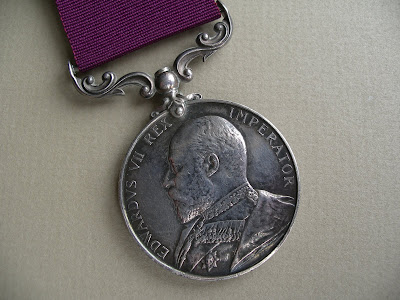
Edward VII Army Long Service & Good Conduct Medal.
68596 Sjt. J. W. Kemp, RFA.
John William Kemp, a 19 year old farm servant, enlisted as a gunner in the Royal Artillery at Grimsby on 29th August 1888, agreeing to serve seven years with the Colours and a further five years in the First Class Army Reserve. His Attestation Papers describe him as having a fair complexion, grey / hazel eyes and red hair. The first ten years of his army service were to be in the UK. He received his first Good Conduct Pay on 29th August 1890 and gained steady promotion to Bombardier (29/01/93), Corporal (1/04/95) and Sergeant (11/09/97). In 1893, John had married Edith Minnie Collier in Newcastle and in December 1894 he had extended his service to complete 12 years with the Colours. In 1896 his wife was brought on the establishment.
In February 1899, John Kemp sailed for India and his first experience of foreign service. Serving with the 53rd Battery RFA, he would stay in India less than a year before being sent to South Africa with the Battery in September 1899. John Kemp stayed in South Africa almost two years and earned his entitlement to a Queen's South Africa Medal with clasps for "Defence of Ladysmith", "Laing's Nek" and "Belfast". The 53rd Battery was present in Ladysmith throughout the siege and saw much fighting. According to "British Regiments in South Africa": On the night of 7th December they took part in a reconnaissance which Sir George White said was well carried out. On 6th January, during the great attack, the battery excelled its previous efforts. "These guns, most ably handled, came into action on Klip River Flats, ... and inflicted very heavy losses on the enemy." On the day of the relief the 53rd and 67th were sent out to harass the retreating enemy, but the horses were too far gone. John Kemp returned to England in August 1901 and in October of that year re-engaged at Woolwich to complete 21 years service. His subsequent service was with the 42nd and 34th Batteries RFA and later with the 2nd Northumbrian Brigade. In 1907, he qualified as Brigade Instructor of Musketry and in October of the same year was awarded his Long Service and Good Conduct Medal with a gratuity of £5.
John Kemp returned to England in August 1901 and in October of that year re-engaged at Woolwich to complete 21 years service. His subsequent service was with the 42nd and 34th Batteries RFA and later with the 2nd Northumbrian Brigade. In 1907, he qualified as Brigade Instructor of Musketry and in October of the same year was awarded his Long Service and Good Conduct Medal with a gratuity of £5.
On 9th May 1914, Battery Sergeant Major Kemp was discharged from the army at Hull. He was 45 years and 6 months in age and had served for over 25 years. His Discharge Papers describe his character as "exemplary" and add the comment that "he is thoroughly honest, sober and trustworthy and is a very hard-working, capable and reliable man, his battery books have always been exceedingly well-kept and he has good knowledge of keeping accounts."




